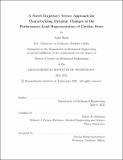A Novel Trajectory Vector Approach for Characterizing Dynamic Changes in the Performance-Load Representation of Cardiac State
Author(s)
Shen, Julie
DownloadThesis PDF (4.376Mb)
Advisor
Edelman, Elazer R.
Terms of use
Metadata
Show full item recordAbstract
In this work, we present a novel trajectory vector approach to both qualitatively and quantitatively characterize dynamic changes in the performance-load cardiac relationship for application in the context of cardiogenic shock. The performance-load relationship is an expansion on the Frank-Starling mechanism that allows traditional metrics of preload to be correlated with afterload, combining both types of load into a more comprehensive general cardiac load. Through a series of controlled animal studies, we collect hemodynamic data during baseline and various pharmacological interventions while the animal is supported by a percutaneous ventricular assist device to test the feasibility of this approach. Utilizing a 2D Frank-Starling representation of the hemodynamic animal data, we employ Gaussian mixture model clustering to identify distinct patterns in an animal’s drug response. These patterns guide the formulation of trajectory vectors, parameterized by angle and magnitude, for each drug effect. Feasibility of the trajectory vector approach is validated through confirming the independence of angle and magnitude from baseline state. The ability of the approach to detect changes across a spectrum of distinct cardiac states and distinguish intervention dose levels, with minimal influences from the level of Impella support, is realized. With the ability to monitor shifts in performance-load relationship, a reflection of the heart’s current inotropic state, our technique can be applied in the clinic to inform appropriate pharmacological treatment and device management for patients with cardiogenic shock.
Date issued
2022-05Department
Massachusetts Institute of Technology. Department of Mechanical EngineeringPublisher
Massachusetts Institute of Technology